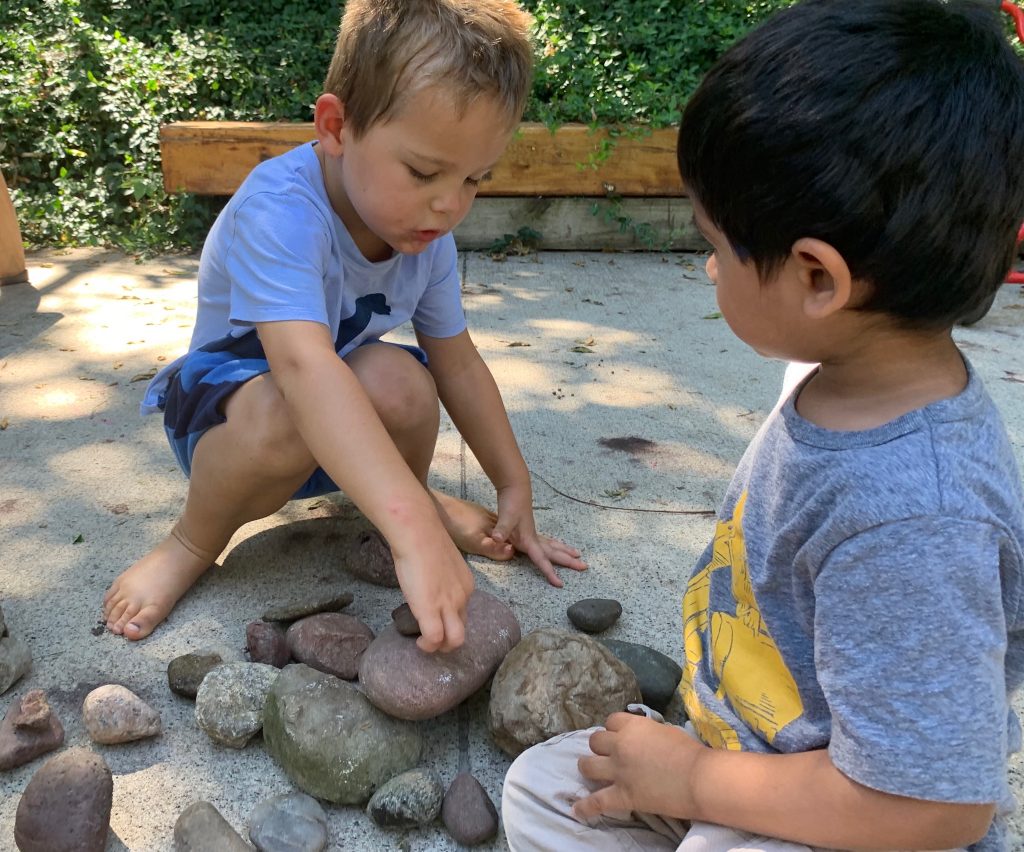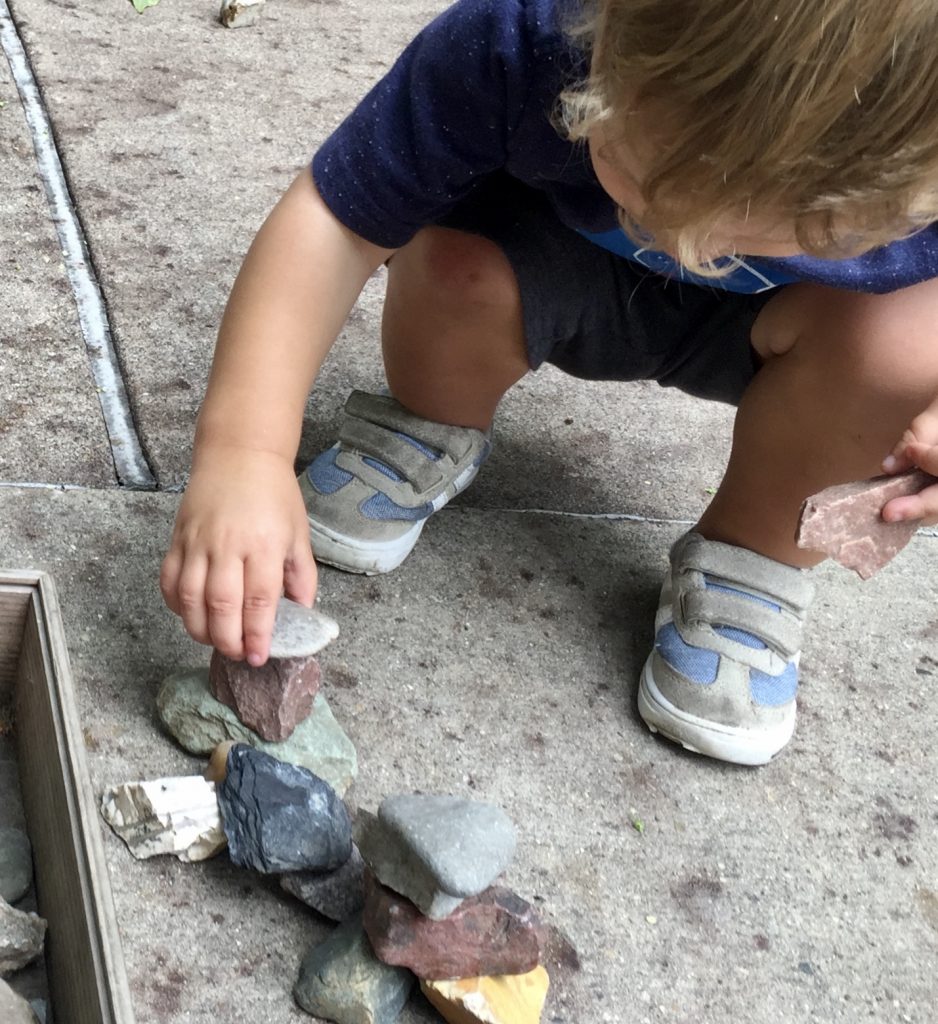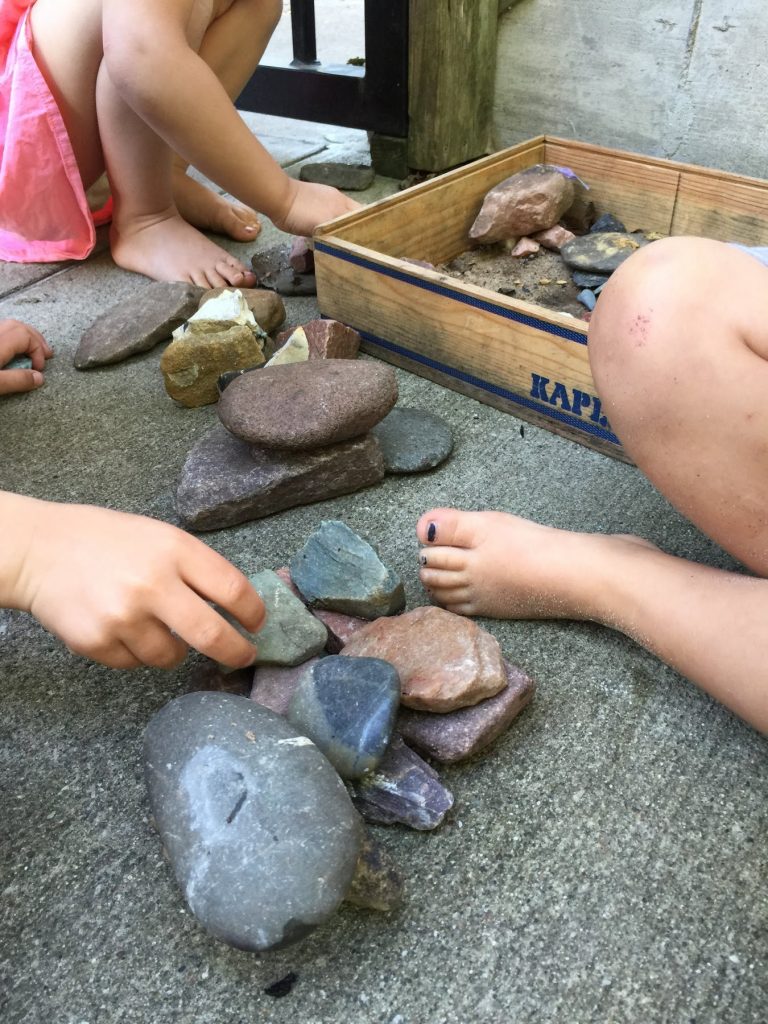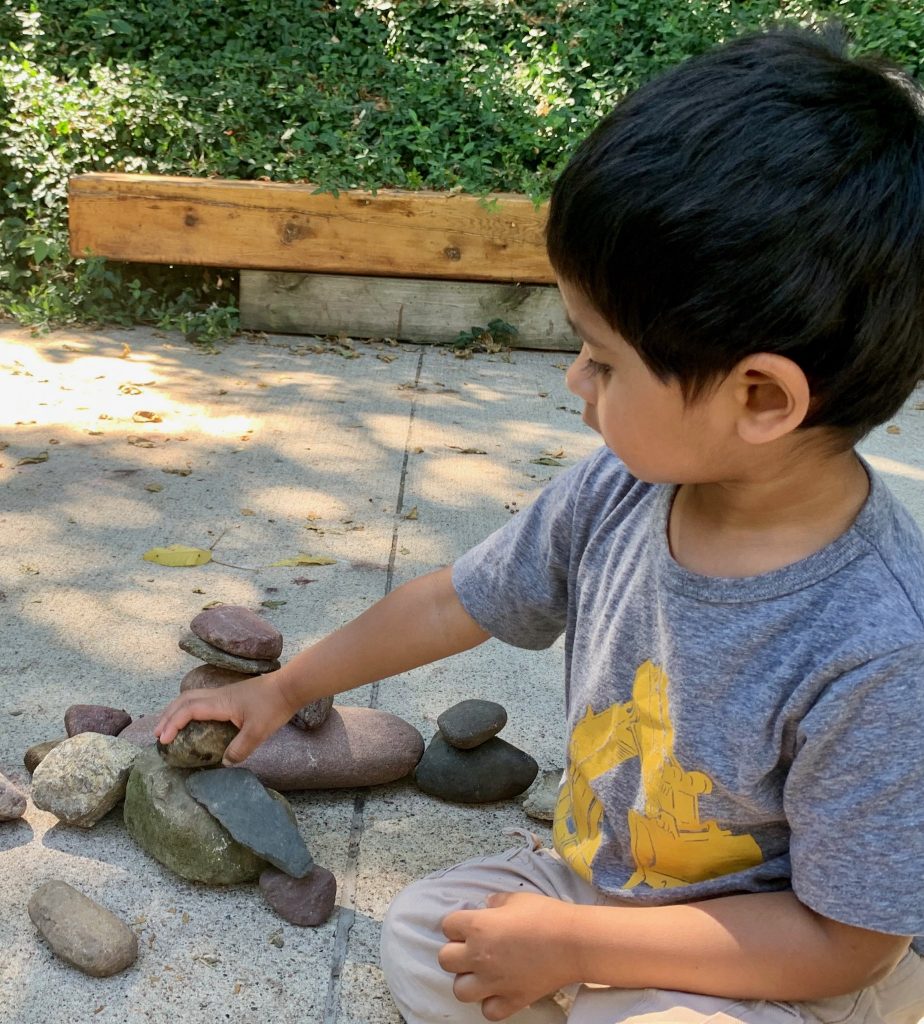Rocking through Early Learning Standards

Rock balancing or CAIRNS has found its way into our play again this week!
Stacking and balancing rocks encourages math and science investigations that are always developmentally appropriate. My adrenaline starts flowing and a smile grows on my face when a two-year-old child exhibits an innate sense of how to balance many more rocks than her much-older peers. Children have their own unique gifts; we just need to give them opportunities to discover their strengths and talents.

For the record, environmentalists strongly discourage this practice because it disrupts the natural order of nature. I get that. When we are hiking or playing in the woods, we follow that rule. Our outdoor classroom has a dry creek and wonderful rocks collected from parking lots and estate sales. These are our math and science rocks that are used for play.

Children who are math-and-science ready are great problem solvers. When our friends explore the concept of stacking, they make observations, collect data and investigate shapes and sizes and weight. We count, we estimate, we balance, we hypothesize. It’s science, math, language and play all wrapped up in the beauty of nature. Nothing makes me happier than finding hidden stacks of rocks somewhere in our play yard—stacks that have been left behind by inquisitive children who didn’t need to please anyone but themselves.

Two-year-old Lauren created the “ant house” above. I love that she decorated her house with flowers. I watched as she wandered over to the sandbox on the other side of the play yard to return with a handful of sand to sprinkle on the roof. I love that intentionality and vision. I love that she is barefoot with a toenail that is black and blue and may fall off, evidence of some already-forgotten adventure that didn’t go as planned. I love that she is laying the foundation for later learning in math, science and engineering through play.
You can call it STEM, STEAM or STREAM, but it’s basic childhood play. It’s long hours of uninterrupted exploration as a child works to bring an idea to fruition. It’s the brain on fire, building the synapses of learning. It’s the cement in the foundation of a lifelong learner—the evolution of a visionary, problem-solving, risk-taking master.

I often hear early educators worry out loud about meeting the benchmarks or standards required by their programs. My tip for this is to bring in natural materials, give your children TIME to play, take photos and sit down with your standards. You will be shocked at how easy this can be. Engaging young children in daily problem-solving activities will help them develop the processing skills that pave the way for future lessons in math and science. This rock-stacking experience is all about shapes and spatial reasoning. This is geometry! This is engineering! This is spatial orientation as our rock stackers exhibit an understanding of location and ordinal position. Our young stackers are often meeting standards and benchmarks before they have the vocabulary to tell us what they are doing. They gather data about their surroundings as they figure out how to balance a specific rock in the stack. And if that rock won’t balance, they’ll try another. This is organizing data and information. They are busy making predictions about outcomes by playing with rocks.

Always bear in mind, however, that brain development varies in children.
Some children may not yet be ready to meet certain standards. Some may be advanced in one area, while others may be advanced in another.
This is when you are smarter than the standards! You can’t teach a rock to balance if the rock can’t balance. You can’t teach a brain a concept if it isn’t developmentally ready to process that concept.
This is why it’s important to reassure parents that their children will be just fine in life, regardless of their child’s test scores on any given day. You can look parents in the eye on Parent Night and share all of the standards that their children have mastered through play. Then you can assure them that play is laying the foundation for the brain development and problem-solving skills that will serve their children well throughout their lives.

So bring in the math rocks. Your students will soon be sorting, comparing and working with attributes. This is an early educator’s dream.
Best of all, it’s fun! Fun for the child, a true delight for the teacher to behold and such wonderful food for the brain.
Stay safe and keep on rocking on!
this could work well with learning patterns by the color of the rocks or the size and creating simple ab patterns.
‘”Stacking and balancing rocks,” counting them as they go along, goes across the early childhood spectrum of abilities.
In the development of early childhood number sense, we know as age increases, the ability to count higher numbers also increases. Younger children tend to compete with older and thereby learn faster.
In the development of early childhood number sense this could work well with learning patterns by the color of the rocks.
kids would love to measure with rocks
I really enjoyed this section of Early Math Counts because once again i learned a new vocabulary word that i would never have thought of in a million years. This falls in the line of patterns and measurements. You can ask the children to put rocks in patterns by big or small, or ask how many rocks do you need to stack to make tall or short, or how many rocks do we need to make the bucket heavy ?
I feel like rocks are one of those all purpose activities similar to blocks. There is a variety of math activities children can do with rocks: sorting big and small, counting, measuring how big someone with rocks, stacking, fine motor skills (placing the rocks in and out of a container with tongs, gross motor skills (throwing/skipping the rocks in a lake) etc.
Feel children would love to engage in learning through rocks so many different ways to use them and incorporate the learning process through play
I agree with your comment, about the different ways you can incorporate different learning through rocks and the children can also help collect the rocks for it to be hands on.
Young children enjoy counting things in their environmet which makes this outside play a great learning environment.
Rock sorting and stacking is enjoyed so much by children of all ages. I feel learning skills through this type of activity is essential to the early childhood brain.
Stacking and balancing rocks encourages children to work on the spatial orientation of not only position, on top of under but also direction up, down
This is an interesting way for children to learn about spatial orientation that also includes using the up, down, on top of, and under positions while stacking up the rocks.
Rocks are so open ended I enjoy how many different ways rocks can be used!
Another great way to get children outside and a way to use math vocabulary as they play. Thank you!